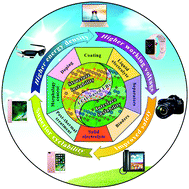当前位置:
X-MOL 学术
›
Chem. Soc. Rev.
›
论文详情
Our official English website, www.x-mol.net, welcomes your feedback! (Note: you will need to create a separate account there.)
Reviving lithium cobalt oxide-based lithium secondary batteries-toward a higher energy density
Chemical Society Reviews ( IF 46.2 ) Pub Date : 2018-06-29 00:00:00 , DOI: 10.1039/c8cs00322j Longlong Wang 1, 2, 3, 4, 5 , Bingbing Chen 1, 2, 3, 4, 5 , Jun Ma 1, 2, 3, 4, 5 , Guanglei Cui 1, 2, 3, 4, 5 , Liquan Chen 1, 2, 3, 4, 5
Chemical Society Reviews ( IF 46.2 ) Pub Date : 2018-06-29 00:00:00 , DOI: 10.1039/c8cs00322j Longlong Wang 1, 2, 3, 4, 5 , Bingbing Chen 1, 2, 3, 4, 5 , Jun Ma 1, 2, 3, 4, 5 , Guanglei Cui 1, 2, 3, 4, 5 , Liquan Chen 1, 2, 3, 4, 5
Affiliation

|
By breaking through the energy density limits step-by-step, the use of lithium cobalt oxide-based Li-ion batteries (LCO-based LIBs) has led to the unprecedented success of consumer electronics over the past 27 years. Recently, strong demands for the quick renewal of the properties of electronic products every so often have resulted in smarter, larger screened, more lightweight devices with longer standby times that have pushed the energy density of LCO-based LIBs nearly to their limit. As a result, with the aim of achieving a higher energy density and lifting the upper cut-off voltage of LCO above 4.45 V (vs. Li/Li+), the development of LCO-based all-solid-state lithium batteries (ASSLBs) with a Li metal anode and LCO-based full cells with high-performance anodes have become urgent scientific and technological requirements. This review summarizes the key challenges of synthesizing LCO-based LBs with a higher energy density from the perspectives of structure and interface stability, and gives an account of effective modification strategies in view of the electrodes, liquid electrolytes, binders, separators, solid electrolytes and LCO-based full cells. The improvement mechanisms of these modification strategies and the controversy over them are also analyzed critically. Moreover, some perspectives regarding the remaining challenges for LCO-based LBs towards a higher energy density and possible future research focuses are also presented.
中文翻译:

使基于锂钴氧化物的锂二次电池恢复活力,朝着更高的能量密度方向发展
通过逐步突破能量密度限制,过去27年来,基于锂钴氧化物的锂离子电池(基于LCO的LIB)的使用已导致消费类电子产品取得空前的成功。最近,对电子产品的性能快速更新的强烈需求导致了更智能,更大屏幕,更轻巧的设备以及更长的待机时间,这使基于LCO的LIB的能量密度几乎达到极限。因此,为了达到更高的能量密度并将LCO的最高截止电压提升至4.45 V以上(vs. Li / Li +),具有锂金属阳极的LCO基全固态锂电池(ASSLB)和具有高性能阳极的LCO基全电池的开发已成为迫切的科学技术要求。这篇综述从结构和界面稳定性的角度总结了合成具有较高能量密度的基于LCO的LB的关键挑战,并针对电极,液体电解质,粘合剂,隔板,固体电解质和基于LCO的全电池。还对这些修改策略的改进机制及其争议进行了严格的分析。此外,还提出了一些有关基于LCO的LB朝着更高能量密度的挑战的观点,并提出了可能的未来研究重点。
更新日期:2018-06-29
中文翻译:

使基于锂钴氧化物的锂二次电池恢复活力,朝着更高的能量密度方向发展
通过逐步突破能量密度限制,过去27年来,基于锂钴氧化物的锂离子电池(基于LCO的LIB)的使用已导致消费类电子产品取得空前的成功。最近,对电子产品的性能快速更新的强烈需求导致了更智能,更大屏幕,更轻巧的设备以及更长的待机时间,这使基于LCO的LIB的能量密度几乎达到极限。因此,为了达到更高的能量密度并将LCO的最高截止电压提升至4.45 V以上(vs. Li / Li +),具有锂金属阳极的LCO基全固态锂电池(ASSLB)和具有高性能阳极的LCO基全电池的开发已成为迫切的科学技术要求。这篇综述从结构和界面稳定性的角度总结了合成具有较高能量密度的基于LCO的LB的关键挑战,并针对电极,液体电解质,粘合剂,隔板,固体电解质和基于LCO的全电池。还对这些修改策略的改进机制及其争议进行了严格的分析。此外,还提出了一些有关基于LCO的LB朝着更高能量密度的挑战的观点,并提出了可能的未来研究重点。



























 京公网安备 11010802027423号
京公网安备 11010802027423号